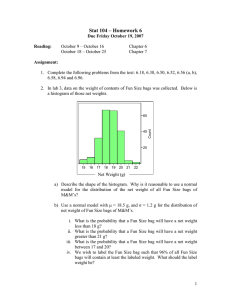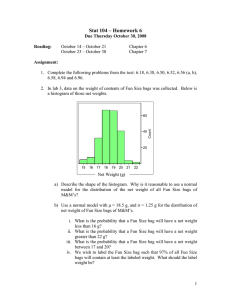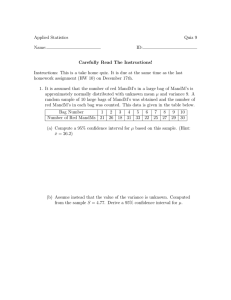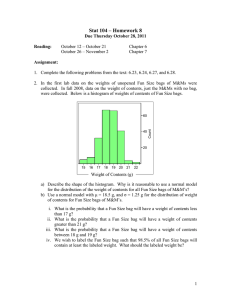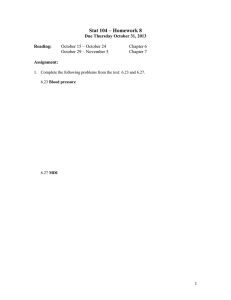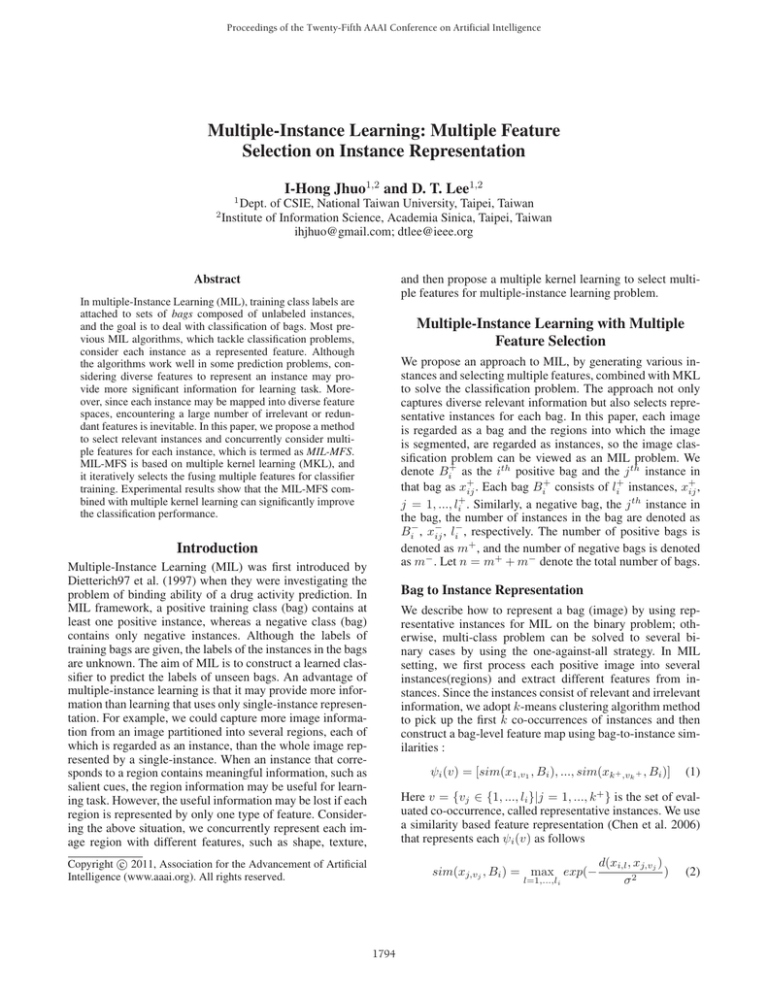
Proceedings of the Twenty-Fifth AAAI Conference on Artificial Intelligence
Multiple-Instance Learning: Multiple Feature
Selection on Instance Representation
1
2
I-Hong Jhuo1,2 and D. T. Lee1,2
Dept. of CSIE, National Taiwan University, Taipei, Taiwan
Institute of Information Science, Academia Sinica, Taipei, Taiwan
ihjhuo@gmail.com; dtlee@ieee.org
and then propose a multiple kernel learning to select multiple features for multiple-instance learning problem.
Abstract
In multiple-Instance Learning (MIL), training class labels are
attached to sets of bags composed of unlabeled instances,
and the goal is to deal with classification of bags. Most previous MIL algorithms, which tackle classification problems,
consider each instance as a represented feature. Although
the algorithms work well in some prediction problems, considering diverse features to represent an instance may provide more significant information for learning task. Moreover, since each instance may be mapped into diverse feature
spaces, encountering a large number of irrelevant or redundant features is inevitable. In this paper, we propose a method
to select relevant instances and concurrently consider multiple features for each instance, which is termed as MIL-MFS.
MIL-MFS is based on multiple kernel learning (MKL), and
it iteratively selects the fusing multiple features for classifier
training. Experimental results show that the MIL-MFS combined with multiple kernel learning can significantly improve
the classification performance.
Multiple-Instance Learning with Multiple
Feature Selection
We propose an approach to MIL, by generating various instances and selecting multiple features, combined with MKL
to solve the classification problem. The approach not only
captures diverse relevant information but also selects representative instances for each bag. In this paper, each image
is regarded as a bag and the regions into which the image
is segmented, are regarded as instances, so the image classification problem can be viewed as an MIL problem. We
denote Bi+ as the ith positive bag and the j th instance in
+
+
+
that bag as x+
ij . Each bag Bi consists of li instances, xij ,
j = 1, ..., li+ . Similarly, a negative bag, the j th instance in
the bag, the number of instances in the bag are denoted as
−
Bi− , x−
ij , li , respectively. The number of positive bags is
denoted as m+ , and the number of negative bags is denoted
as m− . Let n = m+ + m− denote the total number of bags.
Introduction
Multiple-Instance Learning (MIL) was first introduced by
Dietterich97 et al. (1997) when they were investigating the
problem of binding ability of a drug activity prediction. In
MIL framework, a positive training class (bag) contains at
least one positive instance, whereas a negative class (bag)
contains only negative instances. Although the labels of
training bags are given, the labels of the instances in the bags
are unknown. The aim of MIL is to construct a learned classifier to predict the labels of unseen bags. An advantage of
multiple-instance learning is that it may provide more information than learning that uses only single-instance representation. For example, we could capture more image information from an image partitioned into several regions, each of
which is regarded as an instance, than the whole image represented by a single-instance. When an instance that corresponds to a region contains meaningful information, such as
salient cues, the region information may be useful for learning task. However, the useful information may be lost if each
region is represented by only one type of feature. Considering the above situation, we concurrently represent each image region with different features, such as shape, texture,
Bag to Instance Representation
We describe how to represent a bag (image) by using representative instances for MIL on the binary problem; otherwise, multi-class problem can be solved to several binary cases by using the one-against-all strategy. In MIL
setting, we first process each positive image into several
instances(regions) and extract different features from instances. Since the instances consist of relevant and irrelevant
information, we adopt k-means clustering algorithm method
to pick up the first k co-occurrences of instances and then
construct a bag-level feature map using bag-to-instance similarities :
ψi (v) = [sim(x1,v1 , Bi ), ..., sim(xk+ ,vk + , Bi )]
(1)
Here v = {vj ∈ {1, ..., li }|j = 1, ..., k + } is the set of evaluated co-occurrence, called representative instances. We use
a similarity based feature representation (Chen et al. 2006)
that represents each ψi (v) as follows
c 2011, Association for the Advancement of Artificial
Copyright Intelligence (www.aaai.org). All rights reserved.
sim(xj,vj , Bi ) = max exp(−
l=1,...,li
1794
d(xi,l , xj,vj )
)
σ2
(2)
Here σ is a constant and d(x,y) is the distance between two
instances. The similarity between a representative instance
xj,vj and a bag Bi is evaluated by the instance and the closest instance in the bag.
Multiple Kernel Learning for Feature Selection
While multiple kernel learning, e.g.,Xu et al. (2010), Jhuo
et al. (2010), achieves good performance on the classification tasks, we generate diverse features for each instance
and develop an MKL algorithm to more effectively fusing
multiple features. To extract different instance information
for MKL algorithm, we adopt two instance descriptors and
their associated distance functions for kernel construction.
Gist: To obtain texture information, we apply the gist descriptor Oliva et al. (2001). The Euclidean distance is used
to construct the RBF kernel. Pyramid HOG (PHOG):The
PHOG descriptor Bosch et al. (2007) is a summarized distribution of oriented gradients. The kernel is established by
χ2 distance. The forms of the different visual features may
be manifold, so we derive a kernel matrix to describe bags
under each visual feature. Suppose we have n training bags
B = {bi , yi }ni=1 , where yi ∈ {+, −}. For each bag bi ∈ B,
we have F kinds of diverse image features. For each feature
f , we convert pairwise distances between training bags to
the f th kernel matrix based on radial basis function (RBF):
Kf (ψi , ψj ) = exp (−γf ψi,f − ψj,f 2 ), for f = 1, 2.., F .
Here γf is a positive constant and ψi,f is evaluated from
Eq. (1). Finally, a unified data representation of multiple
features, i.e., a collection of the kernel matrices {Kf }F
f =1 ,
is established. We exploit the dyadic hypercuts to generate
weak learners from the established kernels {Kf }F
f =1 . For
each kernel and each pair of opposite labeled training data,
a dyadic hypercut hfi,j is constructed by a positive bag bi ,
a negative bag bj and a kernel matrix Kf . Specifically, the
constructed dyadic hypercut weak learner has the following
f
expression: hfi,j (b) = sign(Kf (b, bi ) − Kf (b, bj ) + δi,j
).
f
is a threshold. With diverse visual features transHere δi,j
ferring information embedded in each kernel f as a set of
weak learners, a strong classifier is obtained via the boosting algorithm. The goal of the learning algorithm is to iteratively select hypercuts {ht } that minimizes weighted error,
t followed by updating the weight wt+1 in the next iteration
(Jhuo et al. 2010). The resulting classifier, in the form of a
linear combination of weak classifiers, is
H(x) = sign(
T
αi hi (b)).
Figure 1: Multiple-instance Learning with Single/Multiple
feature selection.
Table 1: Accuracy (%):Image classification results.
Method
1000-Image
our method
83.5
MILES
82.6
MissSVM
78.0
MI-Kernel
81.8
DD-SVM
81.5
et al. 2006), DD-SVM (Chen et at. 2004), MissSVM(Zhou
et al. 2007) and MI-Kernel(Gartner et al. 2002) algorithms.
As for tackling multi-class, one-against-all strategy is employed. Figure 1 and Table 1 show the accuracy of the MIL
with different features selection and other classification results, respectively. The combined multiple features would
obtain better accuracy after several iterations since the selective weak learners provide a significant image representation for image classification. As we can see, our algorithm
achieves the steady result after twenty iterations.
References
Bosch, A.; Zisserman, A.; and Munoz, X. 2007. Image
classification using random forests and ferns. In Proc. ICCV.
Chen, Y., and Wang, J. Z. 2004. Image categorization by
learning and reasoning with regions. Journal of Machine
Learning Research. 5:913–939.
Chen, Y.; Bi, J.; and Wang, J. Z. 2006. Miles: Multipleinstance learning via embedded instance selection. IEEE
Trans. Patt. Anal. Mach. Intell.. 28:1931–1947.
Dietterich, T. G.; Lathrop, R. H.; and Lozano-Perz, T. 1997.
Solving the multiple-instance problem with axis-parallel
rectangles. Artificial Intelligence 89:31–71.
Gartner, T.; Flach, P. A.; Kowalczyk, A.; and Smola, A. J.
2002. Multi-instance kernels. In Proc. ICML., 179–186.
Jhuo, I.-H., and D.T.Lee. 2010. Boosting-based multiple
kernel learning for image re-ranking. In Proc. Multimedia.
Oliva, A., and Torralba, A. 2001. Modeling the shape of
the scene: A holistic representation of the spatial envelope.
International Journal of Computer Vision 42(3):145–175.
Xu, Z.; Jin, R.; Zhu, S.; Lyu, M. R.; and King, I. 2010.
Smooth optimization for effective multiple kernel learning.
In Proc. AAAI.
Zhou, Z.-H., and Xu, J.-M. 2007. On the relation between
multi-instance learning and semi-supervised learning. In
Proc. AAAI.
(3)
i=1
Experiments
One of the most successful applications on multiple-instance
learning is image classification. The dataset 1000-Image is
a collection of natural scene images from COREL, which
contains 10 categories according to object presence. Each
image is regarded as a bag, and the ROIS (Region of Interests) in the image are regarded as instances represented by
Gist and PHOG features. We randomly divide the images
within each category in half such that one for training and
the others for testing. We compare ours with MILES (Chen
1795


